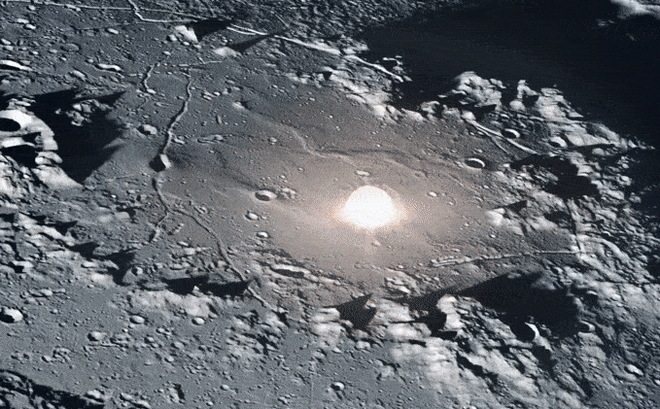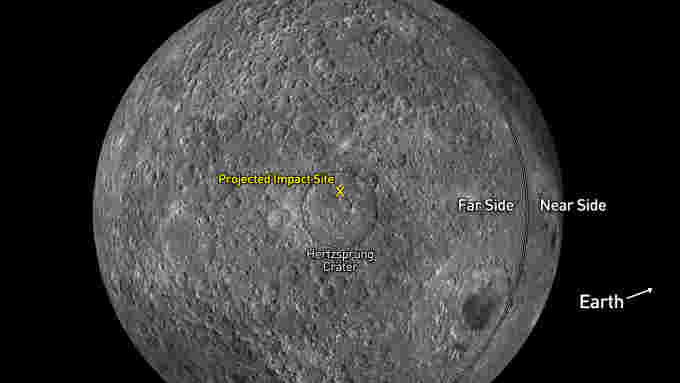To this day, no one knows which country the rocket stage that crashed into the Moon belongs to!
A spent rocket stage recently concluded its 7-year space adventure on March 4, 2022, by crashing into the Moon at a speed of approximately 9,656 km/h, Space reports.

Simulation image of the rocket stage crashing into the Moon. Source: Scitechdaily
According to experts, the event of the rocket stage crashing into the Moon occurred at 12:25 GMT on the far side of the Moon, meaning it was out of the view of ground-based telescopes. NASA’s lunar reconnaissance orbiter might not have been in a favorable position to observe the impact, but the agency has committed to locating the impact crater – a process that could take several weeks or months.
According to a report from Scientific American, the impact crater is believed to be near the naturally formed Hertzsprung crater, which is 570 km wide.

Predicted impact location of the rocket stage crashing on the far side of the Moon on March 4, 2022. Image: NASA / LROC / ASU / Scott Sutherland
The March 4, 2022, impact marks the first known unintentional Moon collision involving a human-made object with a natural celestial body [excluding probes that crashed while attempting to land on the Moon].
NASA had previously directed the third stage of the Saturn V rocket to crash into the Moon’s surface during several Apollo missions, but those impacts were intentional.
WHICH COUNTRY DOES THIS ROCKET STAGE BELONG TO?
Precisely where the 3-ton rocket stage that crashed into the Moon originated from and which country it belongs to remains a matter of ongoing debate.
Initial analyses indicated that the rocket was the Falcon 9 stage from SpaceX (USA) that was launched into space in 2015. Later, it was suggested that it was the Long March 3C rocket stage from China, which was used for the Chang’e-5-T1 mission in 2014.
However, China has refuted this conclusion. Wang Wenbin, spokesperson for the Chinese Ministry of Foreign Affairs (MOFA), confirmed during a regular press conference in Beijing on January 21, 2022, that the used rocket stage about to crash into the Moon is NOT from China’s Chang’e 5-T1 mission conducted eight years ago.
This inadvertently highlights the difficulties astronomers face in observing small objects far from Earth.

Chang’e-5-T1 is the precursor mission to the more famous Chang’e 5 mission, credited with bringing back rare lunar samples to Earth in December 2020.
The first known prediction of the impact came from American astronomer Bill Gray, who runs the Pluto Project, monitoring distant space objects. His initial calculations suggested that the ‘culprit’ was the upper stage of the SpaceX Falcon 9 that launched the Deep Space Climate Observatory (DSCOVR) satellite in February 2015.
However, Gray later revised his analysis after discussions with other astronomers, including Jonathan McDowell, an astronomer at the Harvard-Smithsonian Center for Astrophysics, who regularly tracks satellites and space debris. Gray’s research and several independent observations indicated that the object was actually a part of the Long March 3C rocket that launched China’s Chang’e 5-T1 mission in 2014.
UNUSUAL DETAIL: CHINESE ROCKET STAGE HAS NOT RE-ENTERED THE ATMOSPHERE
As mentioned, China has denied conclusions from American scientists. However, questions arose when SpaceNews cited information from the U.S. Space Command indicating: The remains of the Long March 3C rocket (launched in 2014) have yet to re-enter Earth’s atmosphere, contrary to earlier reports from the 18th Space Control Squadron of the U.S. Space Force that stated the Long March 3C re-entered the atmosphere in October 2015.
Currently, the 18th Space Control Squadron is determining the appropriate update for its space catalog. However, this squadron cannot confirm which country the rocket that crashed into the Moon belongs to.
A spokesperson for the U.S. Space Command told SpaceNews in an email: “With over 43,000 objects we track daily, this number has increased by 1,500 due to the intentional destruction of COSMOS 1408 and the dissemination of approximately 800,000 combined alerts daily, we are focusing on objects closer to Earth.”
The issue of deep space debris is expected to become increasingly important in the coming years as both the U.S. and several partners, along with China and Russia, plan for the Artemis programs and the International Lunar Research Station (ILRS) respectively to establish a long-term presence on the Moon.
Holger Krag, Head of the Space Safety Program at the European Space Agency (ESA), stated: “The impact of a human-made object on the Moon on March 4, 2022, highlights the need for a comprehensive regulatory framework in space, not only for economically critical orbits around Earth but also applicable to the Moon.”


















































